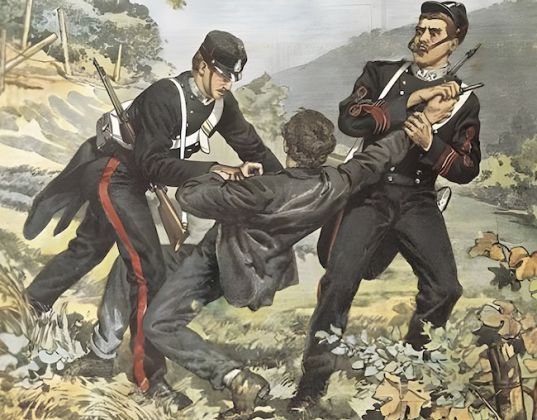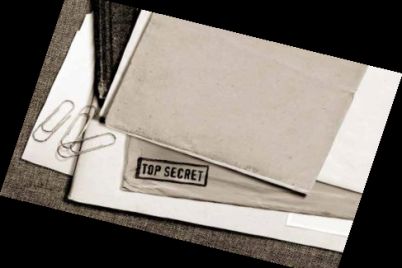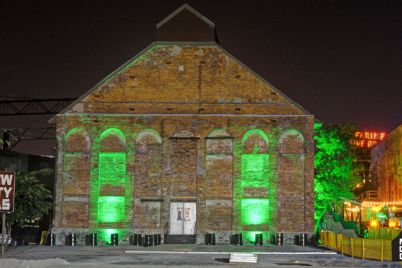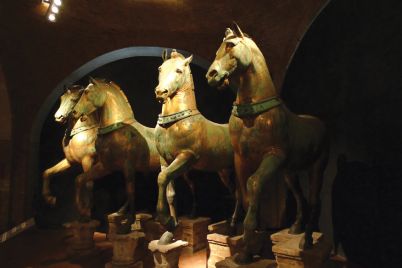“He was the Robin Hood of Italy,” my mother said when she first showed me the tattered old book in Italian that she kept in her cedar chest. I was immediately interested because I was an avid follower of the television series “The Adventures of Robin Hood,” which was very popular in the 1950s. The book told the story of Giuseppe Musolino, a man with the same birth surname as my mother’s. Flipping through those pages, I lingered on an illustration that showed a man in a black and white striped prison uniform, smashing stones with a sledgehammer. He wore an iron ankle shackle with a short length of chain attached to a heavy iron ball, just as I had seen in the old silent movies. Could he really have been the Mediterranean version of the gallant hero of Sherwood Forest? “But Mama, if this man was a hero, why does the drawing show him in prison?” I asked, quite puzzled. She answered that his story was “complicated,” and indeed it is. It is a tale of what happened when a harsh injustice was imposed by the government on an innocent man, provoking him to commit injustices himself.
While some Italians did in fact regard Giuseppe Musolino as the “Robin Hood of Italy,” he was known to others as a cunning, remorseless murderer. The drama surrounding Musolino’s life at the beginning of the 20th century was well recounted at the time by major newspapers in Europe and the United States. While there are many accounts containing half-truths and sometimes even completely fictionalized escapades, there is a short list of information generally recognized as historically accurate.
Giuseppe Musolino was born on September 24, 1876, in the isolated hill town of Santo Stefano d’Aspromonte, Calabria. He was of peasant origin, although he claimed to be descended from French nobility. He worked as a woodcutter, charcoal maker, carpenter, and occasional waiter in his father’s tavern. In 1897, at the age of 21, he was accused of the attempted murder of a political rival, and according to some, also a rival in love. He was arrested, tried and convicted, only to escape and lead authorities on a nearly three-year long manhunt. His second arrest resulted in a show trial that garnered attention world wide.
Santo Stefano sits high in the Aspromonte Mountains, the wildest part of the southern Apennine range, about 650 kilometres southeast of Rome near the toe of the Italian boot. It is a remote area, but one of spectacular scenic beauty, rich in history and tradition. Greeks who colonized the area around 1500 BC referred to the local inhabitants as “Italoi,” which led to the region and eventually the whole country being called Italia. Roman legions camped here in the second century BC during the wars with Carthage. Most towns in the area were built after the fall of the Roman Empire, specifically because their isolation afforded a manner of security, as the empire’s collapse had exposed the region’s coastal settlements to frequent raids by a host of plunderers – Ostrogoths, Byzantines, Arabs, Normans, French, and Spaniards. With each new sovereign came new laws, policies, and procedures proclaimed in a language most could not understand. What remained constant was the poverty, illiteracy, and desperation of the peasant class.
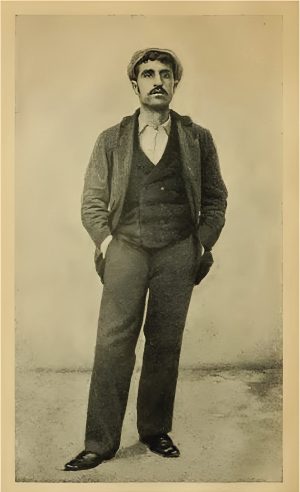
Giuseppe Musolino, date uncertain. Photo courtesy of the author.
The Unification of Italy in 1861 brought Calabria and the whole Mezzogiorno into a union with the rest of the Italian peninsula, but it wasn’t particularly good news for most people, save the minority of revolutionaries and visionaries who had orchestrated the creation of the new nation. At the time, only one person in forty spoke what we know today as standard Italian. Southerners were immediately disparaged and exploited by those in the north of the country.
ON OCTOBER 27, 1897, GIUSEEPPE MUSOLINO WAS AT HIS FATHER’S TAVERN, Osteria della Frasca, when he became involved in a violent quarrel with Vincenzo Zoccoli and his brother Stefano. Apparently, the dispute started over the delivery of a consignment of hazelnuts. Both men were reputed to be members of the local branch of the picciotteria, a criminal organization. The two, however, were at opposite ends of the social scale, as the Zoccolis were among the more prosperous and influential families in town, while Musolino’s family was of modest means. A full-scale brawl broke out in the tavern; it spilled out into the street, and soon drew in other men. Out came the ubiquitous Calabrian knives with blades almost a foot long. “The struggle would have continued if the partisans of both sides had not arrived on the spot, firing revolver shots and separating the two,” reported The Independent. In the end, Zoccoli had stabbed Musolino in the hand and arms a number of times.
Two days after the altercation, Zoccoli was at his stable when someone shot at him. The assailant had fired from behind a wall or fence and had managed to remain unseen, but Zoccoli was not wounded. His family went to the police and made a statement claiming they had witnesses who had heard the would-be assassin shout out immediately after the shooting, “Are you dead, scoundrel?” and had recognized the voice as Musolino’s. They also alleged that Musolino’s hat was found near the scene and that he had sworn a vendetta against their family.
The police took a long while to decide if charges should be brought, and by the time they decided to arrest him, Musolino had fled. He was on the run for almost six months before he was finally arrested, together with a cousin named Antonio Filastò, who had been involved in the original brawl. They were found sleeping at the house of an aunt who lived in a village in the region.
Shortly after their apprehension, the two were arraigned before the district magistrate and transported to Reggio di Calabria, where Musolino was to stand trial on a charge of attempted murder. He was also charged for publicly swearing a vendetta, which was a crime in Italy. But in many cases, issuing such an oath was seen by southern Italians as an entirely rational response to a transgression, made necessary by the weak and corrupt rule of law in the region. The implication of Musolino’s supposed vendetta was fully understood. He would hold other members of the Zoccoli family responsible for whatever wrong he judged had been done to him, as if they themselves had committed the offense. According to the New York Times, “There was great excitement in Santo Stefano over the affair, most of the people taking the side of Musolino.”
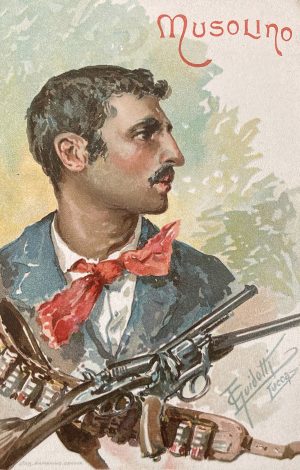
Postcard sold on the streets of Lucca during Musolino’s second trial in 1902. Photo courtesy of the author.
THE TRIAL, WHICH INCLUDED FILASTÒ AS A CO-CONSPIRATOR, was presided over by a judge known to be a protector of an opposing political faction with which Musolino had often been at odds. In the courtroom the defendants sat in the dock, which was a cell with iron bars set up to prevent their communication with others, even their own lawyers, as well as to minimize any potential violent outbursts.
Most sources relate that the charges against the two men were based on circumstantial evidence, and there is little doubt that many witnesses committed perjury, if not for money, then out of intimidation by the Zoccolis. Musolino was furious with each new piece of evidence brought forward, and he often stood up in the dock and shook the bars violently to show his contempt for their testimony. His defence lawyers were not permitted to call several witnesses that would have supported his plea of innocence, which further enraged him. In the end, he was sentenced to 21 years of hard labour, and Filastò was to serve a seven-year term. When the sentence was pronounced, Filastò’s sister collapsed and died.
Both, the guilty verdict and the death of his friend’s sister, provoked Musolino to cry out that he had never declared a vendetta against the Zoccolis, but that he did so now. Livid, he again shook the bars of the dock and shouted that he was innocent and that everyone in the courtroom knew it. He swore revenge against all those who had falsely accused him, testified against him, and handed down the sentence. He said he would escape and kill them all, including the prosecutor and judge.
In turn, he glared at the chief judge, the prosecutor, and the witnesses, and swore he would never accept imprisonment. The Independent reported Musolino shouted, “I shall come out and not one traitor will remain!” He went on to say he would eat Zoccoli’s liver. The room fell silent. Musolino was led out of the dock in handcuffs, and as he was escorted past one of his accusers, he gave him a swift kick. Gasps erupted in the courtroom. There was good reason to believe that if Musolino were ever to escape, he would make good on his vow of revenge.
MUSOLINO WAS DETERMINED NOT TO REMAIN IN PRISON FOR LONG, and he, Filastò, and two other prisoners soon hatched a daring escape plot. They were serving their sentence at the prison fortress of Gerace Marina, located in present-day Locri. It sat atop a 450-metre vertical rock and was considered escape-proof. However, the conspirators soon discovered that the masonry in one section, possibly their communal cell, had deteriorated from within but had gone unnoticed by the prison authorities. Musolino later said that St Joseph had come to him in a dream and suggested the exact portion of the wall where they should dig.
The men secretly fashioned a ladder from bed sheets and slats, the latter serving as rungs. Sometime during the night of January 9, 1899, they broke through the wall, climbed down the makeshift ladder, and undertook a frightening eight-metre freefall. Musolino’s companions were soon recaptured, but Musolino managed to evade his pursuers. He would continue to do so for nearly three years. One of the first things he did was contact a priest to arrange a mass in honour of St Joseph, to give thanks to the saint for having helped him escape.

Postcard sold on the streets of Lucca during Musolino’s second trial in 1902. Photo courtesy of the author.
When news of Musolino’s breakout reached Santo Stefano, it was clear that he would begin exacting revenge upon those whom he believed had wronged him. What wasn’t clear was how lethal and terrifying it would be, and how his actions would capture the interest of the region, the entire country, and ultimately Europe and North America. It still ranks as one of the most bloody and shocking solo acts of retribution in European history.
FOR NEARLY THREE YEARS MUSOLINO ELUDED A MASSIVE MANHUNT conducted by not only the police and Carabinieri, but also by the Italian army. He fulfilled his vendetta. Although the number of people he killed or maimed has never been precisely determined, 17 murders and attempted murders seems to be a credible figure.
The newspapers soon began covering his actions and, because of this, something quite unexpected happened. He promptly became a hero to most of the common people who inhabited Italy’s poverty-stricken Mezzogiorno. Curiously, he also acquired many admirers from among the wealthy. In the mass psyche, he evolved into an equivalent of David doing battle with the Goliath of a corrupt judicial system. Many of the local inhabitants provided him with supplies, information, and shelter, which enabled him to roam free and evade his pursuers, before he was finally captured, tried again, and sentenced to life imprisonment..
In 1901, America’s The Independent, The Nation, and The Outlook published multiple stories about Musolino, as did many other publications, such as The Los Angeles Times, The Washington Post, The New York Times, The Boston Daily Globe (now The Boston Globe), The Times of London, and other newspapers around the world. There have been two films made of his life, one in the silent era and one in the 1950s.
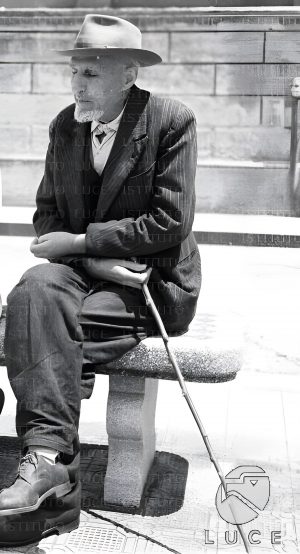
Giuseppe Musolino at the psychiatric hospital in Reggio Calabria in the 1950s, shortly before his death. Photo courtesy of the author.
Giuseppe Musolino intrigued many in Italy and around the globe with his defiance of an entire government to proclaim his innocence and seek his revenge. Hero, rogue, or something in-between, his story is unique in the annals of outlaws.
Postscript: A few years ago, I was part of a training team conducting an exercise at a military base in the port city of Livorno with US and Italian forces, which included a detachment of Carabinieri. During a break, I jokingly told one of them that the Carabinieri had hunted down and captured a relative of mine, a first cousin of my grandfather’s. The officer was genuinely intrigued and told me that Musolino’s case is still included in the academy’s training curriculum. After lunch, I was surprised to find myself surrounded by six or seven smiling Carabinieri who wanted to have a group photo taken with one of Musolino’s relatives. Even today, more than one hundred and twenty years after his trial, Giuseppe Musolino is remembered throughout much of Italy for his bloody vendetta.
Excerpt from King of the Mountains: The Remarkable Story of Giuseppe Musolino, Italy’s Most Famous Outlaw (Smoky City Press, 2023).
Dan Possumato is a retired US Army senior administrative officer and a former Special Investigator for the US Department of State. A graduate of Johns Hopkins University and the US Army War College, Dan’s feature articles have appeared in various US newspaper. Dan’s grandfather Giovanni Musolino was a first cousin of Giuseppe Musolino’s. Dan currently lives in Maine with his wife Ellen.

